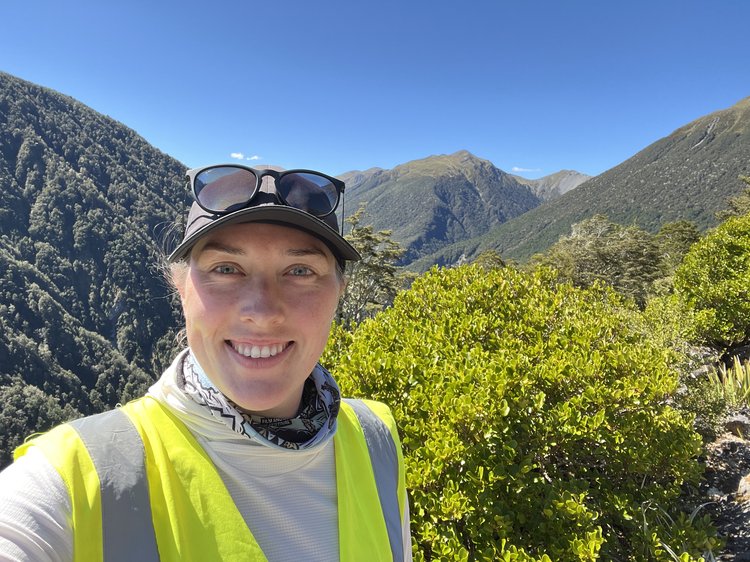People in the Project: Dr Aisling O’Kane
Role in Ngā Ngaru Wakapuke
Aisling is a Postdoctoral Research Fellow in Earth Science at Te Herenga Waka – Victoria University of Wellington. Her research focuses on earthquake and tsunami hazards and ways to mitigate them, using geodynamic modelling, geological fieldwork, satellite data and computational seismology.
In Ngā Ngaru Wakapuke, she is developing physics-based modelling approaches to invert paleo-seismic data for seismic hazard applications. Aisling is investigating past Alpine Fault earthquake behaviour, which is essential for making better estimates of what future earthquake sequences might look like and how to prepare for them.
Beyond her core research, Aisling volunteers her time for international disaster response missions with the UK’s Earthquake Engineering Field Investigation Team and serves as a Standards and Copy-Editor for the diamond-open-access journal, Seismica.
Research background
Aisling completed her PhD in Earth Sciences at the University of Cambridge through an applied Industrial Cooperative Awards in Science and Engineering (iCASE) partnership with Arup. Her research investigated how active tectonics and continental structure influence the seismic hazard of mountain belts and adjacent foreland basins where people live. In collaboration with her hazard-engineering partners, she applied this work to co-develop urban resilience strategies for increasing the resilience of developing cities exposed to strong ground shaking.
In 2023, Aisling joined the University of Canterbury and GNS Science (now ESNZ) as a Resilience to Nature’s Challenges Postdoctoral Research Fellow. She developed a national-scale probabilistic tsunami hazard model for Aotearoa New Zealand from circum-Pacific earthquakes. This included constructing high-resolution subduction zone geometries and using quasi-static earthquake simulators to generate complex rupture scenarios. Her hazard modelling results have been integrated into the first national probabilistic tsunami inundation and risk model for A-NZ.
Current research
In her role within Ngā Ngaru Wakapuke RA2 ‘The Past’, Aisling is currently investigating the frequency and rupture dynamics of past Alpine Fault earthquakes in Aotearoa New Zealand’s central transition zone. Her research integrates lake-derived paleo-seismic shaking records from the past 200 years with NSHM-aligned empirical ground-motion models to identify coherent earthquake sequences at various sites across the western Marlborough region.
Using a forward-modelling approach that treats each lake as a binary ‘seismometer’, Aisling evaluates which earthquake rupture scenarios are consistent with spatial shaking patterns preserved in sediments, helping to constrain past earthquake magnitudes, locations, and recurrence histories. This work will provide key empirical constraints for time-dependent seismic hazard models under development in ‘The Forcast’ theme.

Publications
Peer-reviewed papers:
Boulton, S. J., Jones, J. N., Malcioglu, F. S., O'Kane, A., Cleave, M. D., Adamidis, O., ... & Aktaş, Y. D. (2025). Earthquake environmental effects and ESI 2007 of the 6th February 2023 Kahramanmaraş earthquakes along the East Anatolian Fault Zone (Türkiye). Quaternary International, 732, 109804. https://doi.org/10.1016/j.quaint.2025.109804
O’Kane, A., Copley, A., Mitra, S., & Wimpenny, S. (2022). The geometry of active shortening in the northwest Himalayas and the implications for seismic hazard. Geophysical Journal International, 231(3), 2009-2033. https://doi.org/10.1093/gji/ggac303
Aktas, Y. D., Ioannou, I., Malcioglu, F. S., Kontoe, M., Vatteri, A. P., Baiguera, M., Black, J., Kosker, A., Dermanis, P., Esabalioglou, M., Çabuk, E., Donmez, K., Ercolino, M., Asinari, M., Verrucci, E., Putrino, V., Durmaz, B., Kazantzidou-Firtinidou, D., Cotton, D., O'Kane, A., … & D’Ayala, D. (2022). Hybrid reconnaissance mission to the 30 October 2020 Aegean sea earthquake and tsunami (Izmir, Turkey & Samos, Greece): description of data collection methods and damage. Frontiers in Built Environment, 8, 840192. https://doi.org/10.3389/fbuil.2022.840192
Malcioglu, F. S., O’Kane, A., Donmez, K., & Aktas, Y. D. (2022). Characteristics of Strong Ground Motions in the 30 October 2020, Mw 6.9 Aegean Sea Earthquake. Frontiers in Built Environment, 8, 870279. https://doi.org/10.3389/fbuil.2022.870279
O’Kane, A., & Copley, A. (2021). The controls on earthquake ground motion in foreland-basin settings: the effects of basin and source geometry. Geophysical Journal International, 225(1), 512-529. https://doi.org/10.1093/gji/ggaa599.
Wimpenny, S., Benavente, C., Copley, A., Garcia, B., Rosell, L., O’Kane, A., & Aguirre, E. (2020). Observations and dynamical implications of active normal faulting in South Peru. Geophysical Journal International, 222(1), 27-53. https://doi.org/10.1093/gji/ggaa144
Technical Reports:
Aktaş, Y. D., So, E., Johnson, C., Dönmez, K., Özden, A. T., Vatteri, A. P., O’Kane, A., … & Rossetto, T. (2024). The Türkiye Earthquake Sequence of February 2023: A Longitudinal Study Report by EEFIT. EEFIT, IStructE, https://www.istructe.org/resources/report/eefit-mission-report-turkey-february-2023
Aktas, Y. D., O'Kane, A., Ozden, A. T., Kosker, A., Parammal, A., Durmaz, B., Kazantzidou-Firtinidou, D., Cotton, D., Contreras, D., Verrucci, E., Abduk,. … Putrino, V. (2021). A FIELD REPORT BY EEFIT: The Aegean Earthquake and Tsunami of 30 October 2020. EEFIT, IStructE, https://www.istructe.org/resources/report/eefit-mission-report-aegean-30-october-2020
PhD Thesis:
O’Kane, A. (2023). Active tectonics and earthquake hazards in continental mountain ranges and foreland basins. [Apollo - University of Cambridge Repository]. https://doi.org/10.17863/CAM.97007
